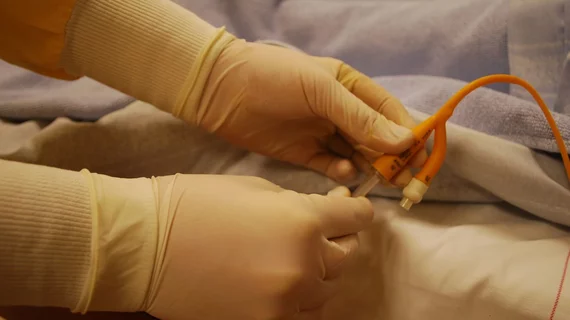Chemicals in plastic medical devices could interfere with cardiac electrophysiology
Heart patients exposed to phthalates—a group of chemicals used as plasticizers in the manufacture of plastic medical products—during invasive procedures may be at risk for serious electrophysiological abnormalities, according to a new study.
The study, published in Circulation: Arrhythmia & Electrophysiology, suggests acute phthalate exposure could be detrimental to patients who come into direct and prolonged contact with mono-2-ethylhexyl phthalate (MEHP), the primary metabolite of di-2-ethylhexyl phthalate (DEHP). DEHP, the most commonly used plasticizer in FDA-approved medical devices, can be found in products ranging from blood storage bags to tubing circuits to catheters.
Heightened phthalate exposure has been noted in patients undergoing a number of procedures that use large quantities of plastic materials, including cardiopulmonary bypass, dialysis, transfusion procedures and extracorporeal membrane oxygenation. Because phthalate additives are hydrophobic and bond to polyvinyl chloride polymers, they’re susceptible to leaching when they come into contact with blood and plasma.
If a patient undergoes multiple medical procedures, their cumulative phthalate exposure can climb to levels 4,000 to 160,000 times higher than what’s considered safe.
“Incidental plastic chemical exposure during medical procedures is virtually unavoidable, yet the direct impact on patient health remains unclear,” lead study author Rafael Jaimes III, PhD, and colleagues wrote. “Because phthalates structurally resemble natural hormones, they can exert endocrine-disrupting properties and interfere with an array of biological processes. Accordingly, phthalates are likely to have a global impact on human health that is multifactorial.”
Jaimes, of the Sheikh Zayed Institute for Pediatric Surgical Innovation in Washington, D.C., and his team performed optical mapping of transmembrane voltage and pacing studies in Langendorff-perfused rat hearts to examine cardiac electrophysiology after MEHP exposure. The whole hearts, which were isolated from the rodents’ bodies, were exposed to varying doses of MEHP for 30 minutes or not at all.
MEHP exposure seemed to increase atrioventricular node and ventricular effective refractory periods after half an hour—the researchers recorded measurements of 147 ms and 117 ms, respectively, in exposed hearts compared to 107 ms and 77.5 ms, respectively, in controls. Optical mapping showed prolonged action potential duration at slower pacing cycle lengths, which the authors said is akin to reverse use dependence.
The team also reported the plateau phase of the action potential duration restitution curve steepened and became monophasic in MEHP-exposed hearts, with a 0.18 versus 0.06 slope in exposed versus unexposed hearts. Longer action potential duration was observed during late-phase repolarization, resulting in triangulation (70.3 ms in exposed hearts vs. 56.6 ms in controls).
Jaimes et al. reported MEHP exposure seemed to slow epicardial conduction velocity, to 35 cm/s in the exposed group and 60 cm/s in the control group. The authors said this finding might be partially explained by the simultaneous inhibition of Nav1.5, a cardiac sodium channel.
Louise Reilly, PhD, and two colleagues said in a related editorial that James and colleagues’ work underlines the need for clinical contextualization and additional investigation of the mechanistic cardiac effects of DEHP and MEHP in humans. The researchers studied their hypothesis in isolated rat hearts, and ex vivo results might differ from in vivo studies.
Reilly and co-authors suggested human cellular models, as well as animal models with cardiac electrophysiology closer to that of humans, could be used for extended in vivo studies of these chemicals. Those subjects, they said, would more closely mimic actual patient exposure to phthalates.
“What clinical impact plasticizers have on human cardiac electrophysiology remains to be determined,” the editorialists wrote. “Despite these gaps, this work contributes to a body of compelling data across various investigators demonstrating that DEHP and MEHP are not inert substances. We readily (and unknowingly) administer these compounds, and at times in high quantity, to some of our most vulnerable patients.”

